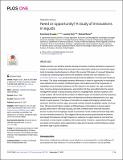Files in this item
Need or opportunity? A study of innovations in equids
Item metadata
| dc.contributor.author | Krueger, Konstanze | |
| dc.contributor.author | Esch, Laureen | |
| dc.contributor.author | Byrne, Richard | |
| dc.date.accessioned | 2021-09-28T16:30:21Z | |
| dc.date.available | 2021-09-28T16:30:21Z | |
| dc.date.issued | 2021-09-27 | |
| dc.identifier | 276067502 | |
| dc.identifier | 7950694e-924f-49b5-99dd-21d25b967706 | |
| dc.identifier | 85116133635 | |
| dc.identifier | 000728983400040 | |
| dc.identifier.citation | Krueger , K , Esch , L & Byrne , R 2021 , ' Need or opportunity? A study of innovations in equids ' , PLoS ONE , vol. 16 , no. 9 , e0257730 . https://doi.org/10.1371/journal.pone.0257730 | en |
| dc.identifier.issn | 1932-6203 | |
| dc.identifier.other | Jisc: fd2788fd589941be87f457363db53a51 | |
| dc.identifier.other | publisher-id: pone-d-21-07512 | |
| dc.identifier.other | ORCID: /0000-0001-9862-9373/work/100901036 | |
| dc.identifier.uri | https://hdl.handle.net/10023/24039 | |
| dc.description | Funding: The article processing charge was funded by the Baden-Württemberg Ministry of Science, Research and Culture and the Nürtingen-Geislingen University, in the funding programme Open Access Publishing. | en |
| dc.description.abstract | Debate persists over whether animals develop innovative solutions primarily in response to needs or conversely whether they innovate more when basic needs are covered and opportunity to develop novel behaviour is offered. We sourced 746 cases of “unusual” behaviour in equids by contacting equid owners and caretakers directly and via a website (https://innovative-behaviour.org), and by searching the internet platforms YouTube and Facebook for videos. The study investigated whether differences in need or opportunity for innovation were reflected in the numbers of different types of innovations and in the frequencies of repeating a once-innovative behaviour (i) with respect to the equids’ sex, age, and breed type, (ii) across behavioural categories, and whether (iii) they were affected by the equids’ management (single vs group housing, access to roughage feed, access to pasture, and social contact). We found that the numbers of different types of innovation and the frequency of displaying specific innovations were not affected by individual characteristics (sex, age, breed or equid species). Few types of innovation in escape and foraging contexts were observed, whilst the comfort, play, and social contexts elicited the greatest variety of innovations. We also found higher numbers of different types of innovations in horses kept in groups rather than in individual housing, and with unlimited rather than with restricted access to pasture and roughage. Equids in permanent social contact performed high rates of once-innovative behaviour. We suggest that equids produce goal-directed innovations and repeat the behaviour at high frequency in response to urgent needs for food and free movement or when kept in conditions with social conflict. However, equids devise the greatest variety of innovations when opportunity to play and to develop comfort behaviour arises and when kept in good conditions. | |
| dc.format.extent | 16 | |
| dc.format.extent | 958410 | |
| dc.language.iso | eng | |
| dc.relation.ispartof | PLoS ONE | en |
| dc.subject | QL Zoology | en |
| dc.subject | NDAS | en |
| dc.subject.lcc | QL | en |
| dc.title | Need or opportunity? A study of innovations in equids | en |
| dc.type | Journal article | en |
| dc.contributor.institution | University of St Andrews. Centre for Social Learning & Cognitive Evolution | en |
| dc.contributor.institution | University of St Andrews. School of Psychology and Neuroscience | en |
| dc.identifier.doi | 10.1371/journal.pone.0257730 | |
| dc.description.status | Peer reviewed | en |
| dc.identifier.url | https://journals.plos.org/plosone/article?id=10.1371/journal.pone.0257730#sec021 | en |
This item appears in the following Collection(s)
Items in the St Andrews Research Repository are protected by copyright, with all rights reserved, unless otherwise indicated.

